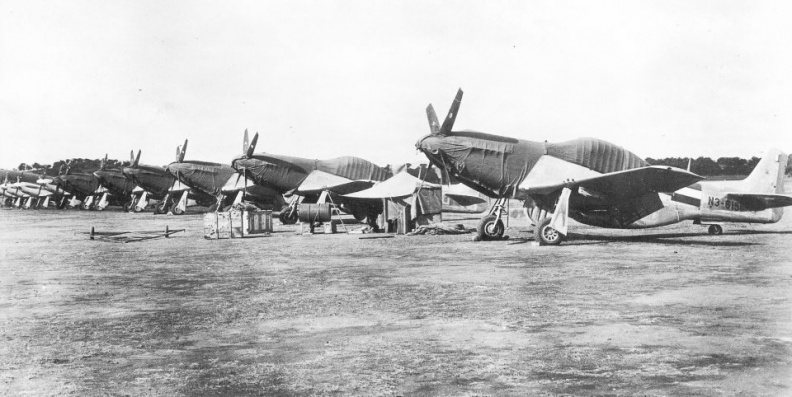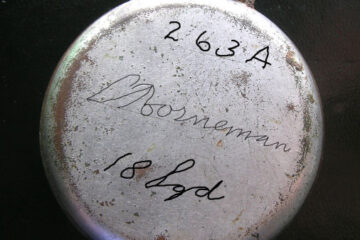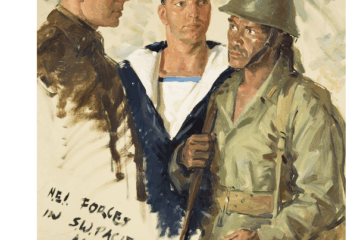The establishment of the NEI Personnel & Equipment Pool (PEP) Squadron, initially stationed at RAAF Base in Canberra, resulted from the need to allow Netherlands East Indies (NEI) crews to recover and prepare for upcoming operations after completing their operational tours. Additionally, they required a base to accommodate spare aircraft and equipment. The 18 Squadron NEI, equipped with B-25 bombers, was formed in April 1942 and had been participating in operations in the NW Area of Australia since January 1943. The crews had to be replaced after a certain time, and the replacements had to come from the military flight school at Jackson, which the Dutch had established in America. By mid-1943, this school had started sending crews to Australia to replace the first group of flying personnel from the 18 Squadron, with two flights arriving in October 1943 and the rest in November and the following months. The last full squadron-sized group arrived in Australia in 1944.
The official establishment of the NEI Aircraft and Personnel Pool (NEI APP) took place on 1 September 1943. Around November 1943, the first fighter pilots trained in America arrived to establish the 120 (fighter) squadron NEI.
On December 28, 1943, the NEI APP comprised: • NEI: 74 officers, 189 non-commissioned officers, corporals, and men. • RAAF: 74 officers, 45 non-commissioned officers, corporals, and men. The RAAF section of the NEI APP was part of the organisation of RAAF Airport Canberra.
From April 1, 1944, this unit was known as NEI Personnel and Equipment Pool (NEI PEP). Organisational strength of the PEP was nine B-25 bombers and nine P-40 fighters, but changes in numbers were possible as circumstances arose. Later, a Wirraway two-person training device was added to the strength. The arrival of Air Force personnel from America, the formation of 120 Squadron, and the return of the relieved crews of the 18th caused major accommodation problems at Canberra. On February 15, 1944, there were 111 officers, and it was foreseeable that this number would rise to 160 within a short time.
The arrival of about fifty Dutch Naval Air Force (MLD) officers at Canberra between February 12 and 14, 1944, did not ease the accommodation problem. Until the well-known hotel ‘Queanbeyan’ could be taken over, many had to be placed elsewhere, for example, in Melbourne at one of the transport departments. During this period, eighteen Australian radiotelegraphers/air gunners were transferred from the RAAF Canberra organisation, and eight from the NEI Aircraft and Personnel Pool (NEI APP); twenty others were reassigned for service with the 18 Squadron at Batchelor as air gunners.
With the liberation of the Netherlands and the pooling of volunteers for the Dutch Air Force, a group of about 250 Dutch individuals formed in England who signed up for training in flying positions. This training was scheduled to take place in Australia, and the Australian government approved the RAAF to provide training for pilots, navigators, and aviation radio operators. Air gunners would be trained at the NEI PEP in Canberra. In return, the NEI PEP would operationally train Australian 13-25 crews. However, the cessation of hostilities in the Pacific on August 15, 1945, and the subsequent surrender of the Japanese armed forces brought an end to the training agreements made with the Dutch. The RAAF, in particular, ceased further training for the Dutch due to demobilisation on January 8, 1946.
By 1945, the NEI PEP in Canberra had evolved into a complete organisation, providing technical support to two operational squadrons and managing spare equipment. Additionally, it conducted all flight training and exercises, within its capacity, for two separate squadrons: the bombers and the fighters. Further increases in personnel and equipment were not possible for the Canberra base. As the combat front moved closer to Japan and the impending invasion of the Dutch East Indies, the NEI Army HQ (HK-KNIL) recognised the need for another base for the NEI PEP.
In April 1945, during an Air Board meeting, a redistribution of various airfields in Australia was discussed for the benefit of the British and Australian air forces. The Dutch wishes were also considered, and Air Commodore J.R. Bell, Director of Organisation HQ RAAF, offered the Dutch a choice between three airports, all located in the state of Queensland: Charter Towers, Evans Head, and Bundaberg. After a visit and subsequent evaluation by Lieutenant-Colonels Fiedeldij and Asjes, it was concluded that Bundaberg airfield had numerous advantages over the others, including the familiar Canberra.
Bundaberg, formerly RAAF Bundaberg, was a training base for advanced student pilots and was well-suited for the operational training of the PEP. The base was located 165 miles north of Brisbane, three miles from the town of Bundaberg, and twelve miles from the coast. It featured a well-designed landing area in the shape of a triangle with expansion possibilities for heavy aircraft. It had good lighting for night flying, radio and navigation equipment, a complete operations room, a fully equipped workshop, eight hangars, link trainers, shooting ranges, magazines, ammunition and fuel stores, two firing tunnels, kitchens, mess facilities, barracks with accommodation for 120 officers, 120 non-commissioned officers, 810 men, and 250 members of the Women’s Army Corps (WAAF). The base also had a well-equipped hospital, quarters for nurses, a fully equipped dental practice room, gym, cinema, four tennis courts, and a large vegetable garden. The climate was subtropical, the environmental health was excellent, and the disease rate was low. The town of Bundaberg had 20,000 inhabitants, and several nice seaside resorts nearby offered relaxation on weekends.
On May 17, 1945, the army commander reported his decision to the Lieutenant Governor-General, Dr. Van Mook, requesting £13,000 for airfield improvements to accommodate medium bombers and transport aircraft. This request was granted in a letter signed by government-secretary Mr. J.G. Kist. However, just three weeks later, the amount had to be increased to £22,000, which was again approved. General Van Oyen received the consideration that future estimates should be drawn up more accurately or subjected to checks. On June 16, 1945, the official decree of the Department of Air Commonwealth of Australia was signed, stating that RAAF Bundaberg would be used by the ML-KNIL. Seven days later, an order was issued, announcing the relocation of NEI PEP from Canberra to Bundaberg, to be completed in the first half of September 1945.
On June 25, a detachment of preparations, led by Captain F.J.W. den Ouden, commenced the move. Flight Lieutenant A.W. McGee served as the RAAF liaison officer, and Cornet D.P. Titaley served as the general adjutant.
The move proceeded rapidly, and after its completion on the stipulated date, the commander of NEI PEP Bundaberg assumed command of the base and also that of No. 88 Operational Base Unit of the RAAF, which had been placed there by RAAF Command on June 14, 1945. This unit was a Resident unit tasked with caring for the RAAF component of the airbase. Additionally, HK-KNIL had plans to move the 19 Transport Squadron, formed on August 15, 1945, from Brisbane to Bundaberg. However, due to the cessation of hostilities, this plan did not proceed, and the 19th remained in Brisbane until its departure for the Dutch East Indies.
Lastly, it should be noted that three days before the end of the war, on August 11, 1945, General Van Oyen inquired with the Secretary Department of Air about the possibility of the Dutch continuing to use Bundaberg after the war until a move to the Dutch East Indies became feasible. Mr. Langslow replied in a letter dated August 29, 1945, stating that “no objection will be raised to the continued occupation of BUNDABERG by the NEI forces for a further reasonable period.” Consequently, the Australians did not object to the Dutch’s continued use of the Bundaberg base until a time determined by the Dutch East Indies Government.
After the war, it would become evident how beneficial this decision was for military aviation personnel liberated from POW camps and sent to Australia for recuperation.

Documents in relation to the move of NEI/Dutch air squadron from Canberra to Bundaberg.
Researched by Ruby Todorovski, University of Queensland
The following website also offers information on the Air Force of the Royal Netherlands East Indies Army. Key in Netherlands East Indies for an overview of available files.


